How to plant a garden correctly? This question is asked by everyone who has just become the owner of a small piece of land.
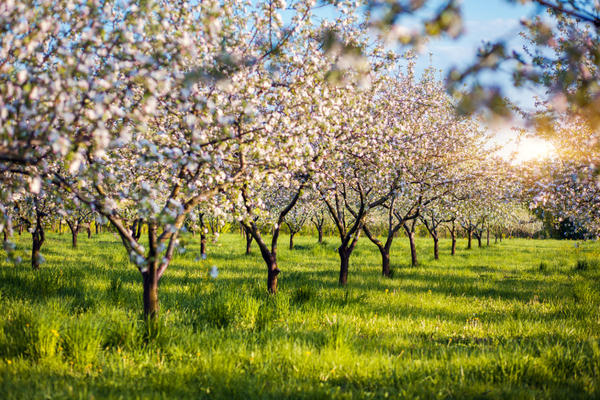
We plant and grow the garden correctly
This question is asked by the one whose mice (like mine) gnawed trees in winter. There are different systems of gardening: here are the advantages and disadvantages of each and will be discussed.
Ancestral experience
Our ancestors always had grass in their gardens. It was mowed for hay, geese and cattle were grazed on it. Fruit trees grew tall, but they did not give birth every year and there were no large harvests. What does this use of land under gardens give? Hay, perhaps, and received some additional amount, and the living creatures left a lot of cakes, but the soil after grazing the herd was so trampled, so compacted that even good rains could not give the garden trees enough moisture.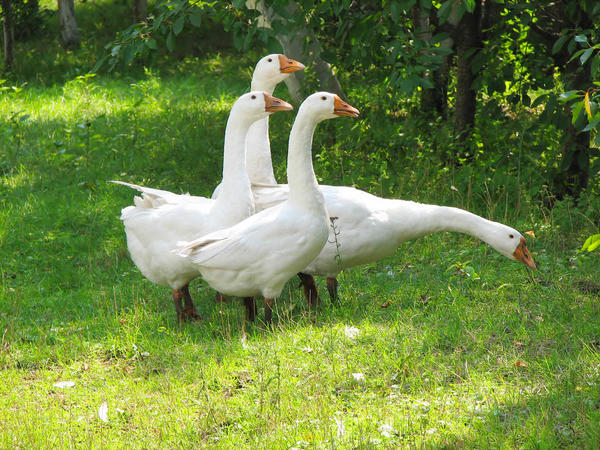
The garden is not a place for grazing livestock and poultry.
The Earth did not receive the required amount of oxygen, carbon dioxide did not linger in it. The soil was depleted, because the mown and eaten grass did not return to it. The conditions under which soil animals (earthworms, woodlice, bacteria and others) are able to restore fertility have disappeared. Not the soil in the garden was obtained, but the road. And how many things on the road can grow? That's right, nothing.
Tilling the soil in the garden
The twentieth century brought new technologies. It is with a shovel or a pitchfork all the soil under the garden trees and in the aisles to dig up too hard and too long. But a plow appeared, and the gardeners realized that the land in the gardens could be plowed and fertilized every year.
Bare ground in the garden
So they left the bare ground under the open sky, without protecting it in any way. That is, there was steam in the garden. Yes, it was so easy to add humus, manure,compost . But the disadvantages of using this technology turned out to be more.
- First and foremost, the soil became less and less every year. Not protected by anything, it was simply washed away by the rains, especially if the garden was located on a slope (cultivation of the land in such gardens gives rise to ravines). Even on the plains, the redistribution of soil still took place, because there are very few absolutely flat fields in the world, and they, as a rule, are not given to gardens.
- The second minus is that the roots of the trees are located so that they use very little of the fertile soil layer, because they lie deeper.
- The third - the roots of the trees were injured when plowing the row spacings (in the apple tree they extend 15 m from the trunk). The root system is difficult to recover, which means that the yield is falling.
Therefore, in gardens with tall trees, aisles can only be plowed to a depth of 20 cm, with medium-sized trees - no more than 15 cm, near-trunk circles - no deeper than 10 cm.Well, this is already working with a hoe can give such a depth of processing. And a person does not compact the soil as much as a tractor.
Given the significant disadvantages, it is clear that it will not be possible to plant a garden correctly with this technology .
Parosideral technology
Seeing the problems described above, gardening scientists recommended reducing the plowing depth to 10 cm, and the roots of the trees immediately occupied the available space. Then they decided that it was not worth using the plow, they switched to milling.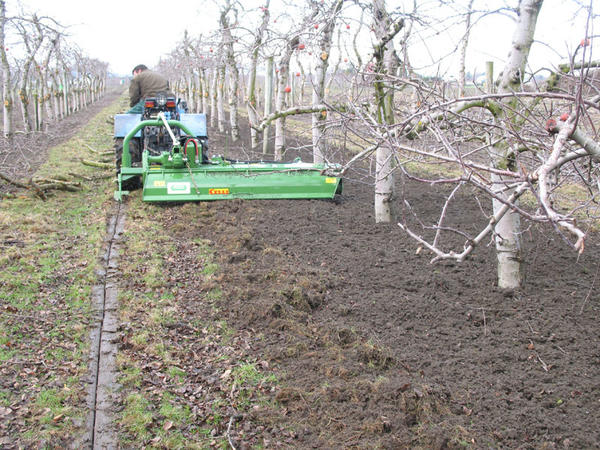
Milling cultivator for inter-row cultivation of gardens. Photo from agro-sistema.ru This helped the soil to partially recover itself. At the same time between the rows began to sow the green manure to then they plow. This method of planting and maintaining a garden was called parisideral. But we already know that green manure does not have to be plowed. This work can be successfully done by earthworms and other soil animals. And the seeds of various green manure can be found in our catalog, which contains the offers of many large garden online stores.
Sod-humus system
After the war, a new system of planting and growing gardens appeared in the USA, Canada, Australia, Japan. It has also been tested in our country, and people have become convinced of its effectiveness. It turns out that grasses just need to be allowed to grow under trees and in the aisles. Cover the garden areas with bluegrass and fescue, prevent them from forming impassable thickets, mowing, chopping and leaving where they grew. Mow 6-7 times per season. If there is a lot of rain, then more often (this is from personal experience). But Mineral fertilisers are still applied. Do not use manure at all, because crushed grass plays the role of compost (and mulch ). Application of mineral fertilizers in a turfed garden. Photo from the site clanki.kupimprodam.si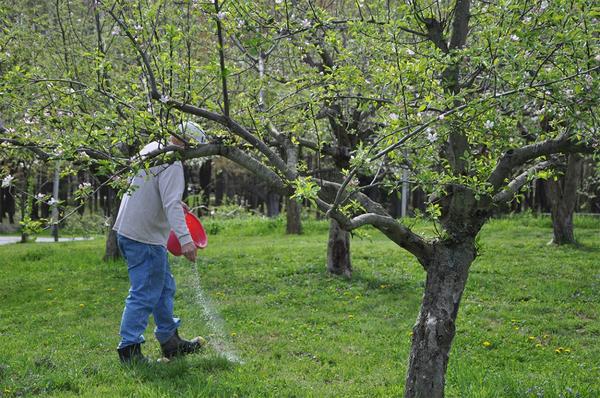
What is the effectiveness of the sod-humus system: such a garden is simple, cheap to maintain. And its yield is great. The roots of trees grow freely in the same soil layer of 10-15 cm, which was previously inaccessible due to plowing. So it turned out the expanse for soil animals. In such a garden, all the earth remains in place, the rains cannot wash it away. The yield increase (compared to other planting systems) reaches 20%! There are fewer scab-affected trees.
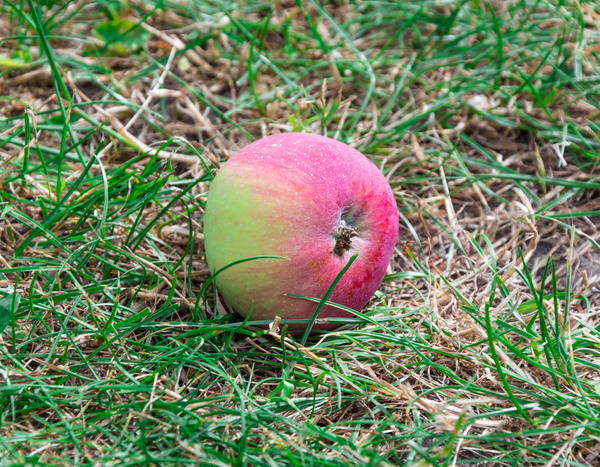
Volunteers are being processed. The
winter hardiness of apple trees does not decrease, the biological rhythm of growth and development of trees does not change. Almost natural farming.
An important condition for laying a garden
But there is one caveat. It turns out that planting on plowed land is considered correct: let the garden live in a steam system for the first two years of life. At this time, the soil must be actively cultivated and fertilized. Then - sow honey plants, which will simultaneously be green manure. It is recommended to draw up the aisles only in gardens that have already begun to yield crops.
It is recommended to draw up the aisles after the seedlings begin to bear fruit.
How to properly plant a garden in the country
This planting system is also recommended for privatof gardens in tiny areas. Only simplify it a little:- do not do any preparation and cultivation of the soil in the garden at all;
- grow a lawn under the trees. Mow it in time, leaving the mowed chopped greens where they grew. But the height of the grass should be left a little higher than on a decorative lawn.

The sod helps the soil to work in a natural rhythm.
In a properly planted orchard, turf not only plays the role of a protector, it helps the soil to work in a natural rhythm and according to natural technologies, to save water, and not to suffer from drought. The trees in such a garden do not suffer from the wrong actions of a person, because he does not interfere,
but helps them: somewhere with a pruner, somewhere with a garter, somewhere with the addition of humus (it must be compensated for by the soil, because trees give a crop). In a properly planted garden, trees of modern varieties should grow (although it is not forbidden to grow old favorites). If you got a plot with ready-made turf (someone has grown a lawn or natural herbs), then mow the grass, leave mulch on the site. Remove the sod at the site of the future near-trunk circles, dig planting holes in advance.
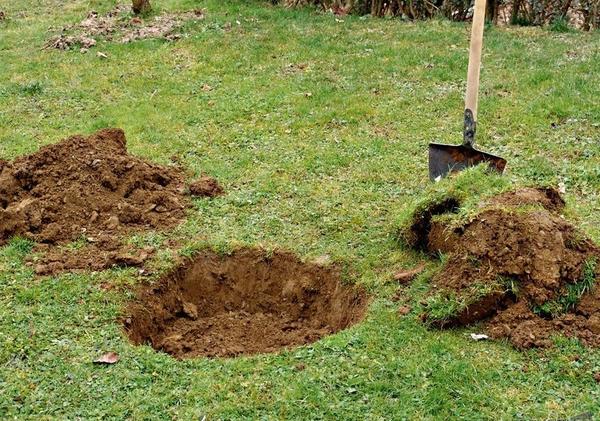
Preparation of the landing pit.
Plant the seedlings correctly, cover the tree trunks with turf, water well. And let nature protect your garden, and it will require minimum labor costs from you. Now it is clear how to plant a garden correctly?

Preparation of the landing pit.
Plant the seedlings correctly, cover the tree trunks with turf, water well. And let nature protect your garden, and it will require minimum labor costs from you. Now it is clear how to plant a garden correctly?
Personal experience of planting and growing a garden
At the time of laying the garden, our site was plowed. I was even glad that it was easy to plant trees, because the soil was prepared. And then I used a hoe to destroy the swan all summer. And it was very difficult to cope with it in order to maintain steam. Then the seeds of all sorts of weeds arrived. Soon it became impossible to carry out such a huge amount of work, and the garden was abandoned. The grass in it grew above the waist, but the lawn did not form. Only when we bought a brushcutter , in two seasons we managed to cope with annual weeds.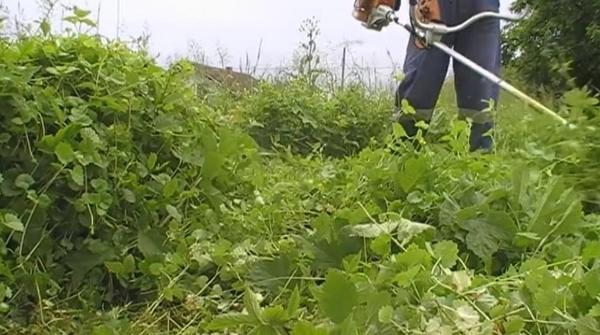
The motokosa helped control the weeds.
and carried them into the garden, under the trees. Once free, they quickly mastered the whole space. We don't walk aimlessly in the garden, we don't trample the earth in vain, we treat it with respect. We have certain paths only for the necessary work. A properly planted garden does not give us a huge amount of hard work, but joy and rich harvests.
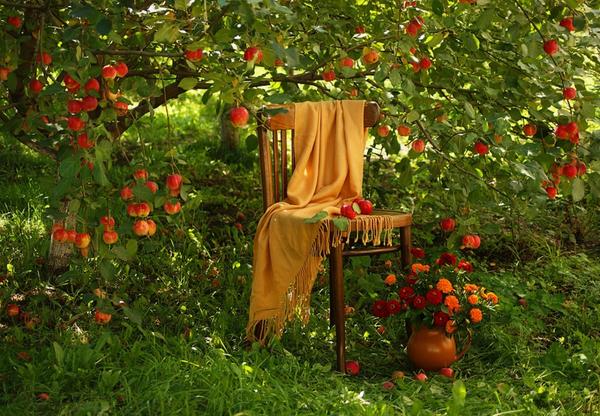
A well-planted garden brings joy.
The basis of a healthy fruitful garden is soil fertility . And it depends on our actions, our choice (whether we help or hinder the soil) which garden we can grow.





.jpeg)


0 Comments
Post a Comment